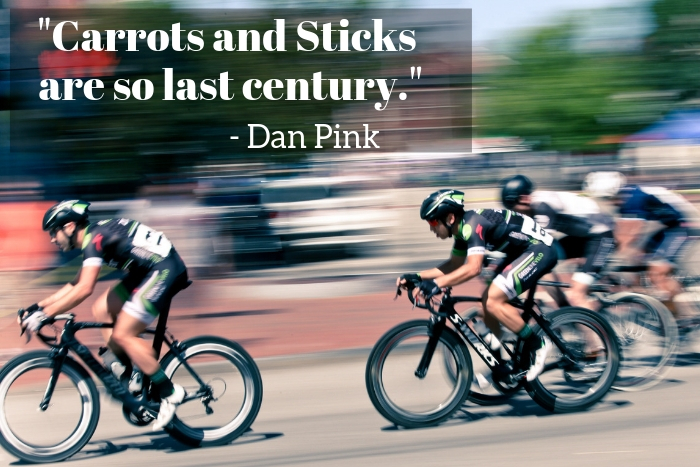What motivates you? A book review of Drive

Why do you do what you do?
What motivates you (or your employees…) to work really hard, come up with great new ideas, do the hard work of leading, planning, making things happen?
The traditional business school answer is that you’re motivated by money and / or the fear of getting fired. If you want someone to work harder or get better results, you offer them a bonus or threaten them.
However if you’re a business owner…or if you’ve spent much time out in the work force you may have realized that the simplistic (but widely held) belief of the carrot and the stick as the only way to get employees to do things doesn’t really ring true. (photo by oakleyoriginals)
If you ask most business owners why they got into business for themselves the most likely answer is that they wanted to be their own boss. I know dozens of people in the corporate world who willingly gave up promotions in exchange for being able to work from home. It’s not about the money (or at least it’s only partially about the money).
It’s that break between what’s commonly practiced in business motivation and what experience (and as it turns out science) tells us that Dan Pink’s latest book Drive is all about.
I really enjoyed this book…for several reasons.
It’s interesting and it has a good beat
Sadly many business books are…to put it nicely…a bit dry. They might cover great ideas or give you great tips, but if you have to force yourself to get through the next chapter, then it’s not much help.
Drive has a lot of stories and interesting facts and the author does a great job of flowing everything together very conversationally with a spirit of discovery and fun.
It’s challenging but with some real scientific basis
There are a lot of interesting, even provocative ideas out there – many of them may even be true, but most of them don’t have much backing to them – leadership theories, marketing theories, get everything you want out of life theories. A lot of strong ideas that may or may not be true.
Drive has a very provocative theme…how business has been motivating people since the beginning of the industrial age no longer really works in today’s world.
But what I find really cool about that is that the author approaches the entire thing as a review of established science that backs up his point. It’s not like he found one study…he cites 1/2 dozen different studies and prominent scientists and really backs up his assertions. I’m very comfortable that this is real world, real stuff.
It’s got some real, practical applications
The whole point of the book is that business needs a new understanding of what motivates people to perform…motivation model 3.0 as he describes it. (1.o is basic survival instincts, 2.0 is reward and punishment). But this isn’t a theoretical concept, there are businesses, very successful businesses out there today that are using at least parts of this new motivation model right now!
This new motivation model is made up of 3 components:
Autonomy – the ability to do what you want to do, when you want to do it, how you want to do it and who you want to do it with. He gave a great example of the Results Only Workspace Environment (ROWE) that’s used at Best Buy Corporate Headquarters where they don’t have standard office hours, choose when and if they want to come into the office and whether they want to go to meetings or not. Oh and by the way, their productivity is up and costs are down since implementing this!
Mastery – The ability to practice and perfect skills (of your choosing) and really taking the time to master them. It’s the pursuit of Mastery that enables people to get into a state of Flow (basically get into the zone of whatever it is they’re doing).
Purpose – The idea that people want to work for an idea or something that’s bigger than themselves. Given a choice, most people would much rather work for a company that’s doing something cool and making a difference.
Obviously it’s not easy to build an organization that fully embraces these ideas, but it is totally possible to start building these ideas slowly into your company culture…there are things you could start doing today that would make your business a more motivating place to work at.
Finally I think biggest reason why this book really resonated with me is the idea that there are workplaces out there where you are compensated fairly (it’s always partly about money), you have a strong level of independence, an opportunity to really grow into what you like doing and you’re doing something bigger than you could pull off by yourself! Shouldn’t all business be like that?
Compare that to the dreary, downtrodden, uptight corporate environments that populate most large companies and it makes for an exciting idea.
Here’s a link to Dan Pink’s TED speech on Drive to give you a better idea of what it’s all about. If you can’t see the video below – here’s a link: Dan Pink – TED
Have you read Drive? Would these ideas work for you? Share your thoughts on how your employees are motivated or what you’ve seen work or not work in the comments below.
Shawn Kinkade Kansas City Business Coach
5 thoughts on “What motivates you? A book review of Drive”
Comments are closed.

Great review of what seems to be a provocative book.
Wonder how one balances the autonomy with collaboration. I hear IT managers complain that it is difficult to get the team together even virtually to work on a problem. If I really need the IT architect for my project and he isn't working or going to meetings, ugh, that seems like a problem.